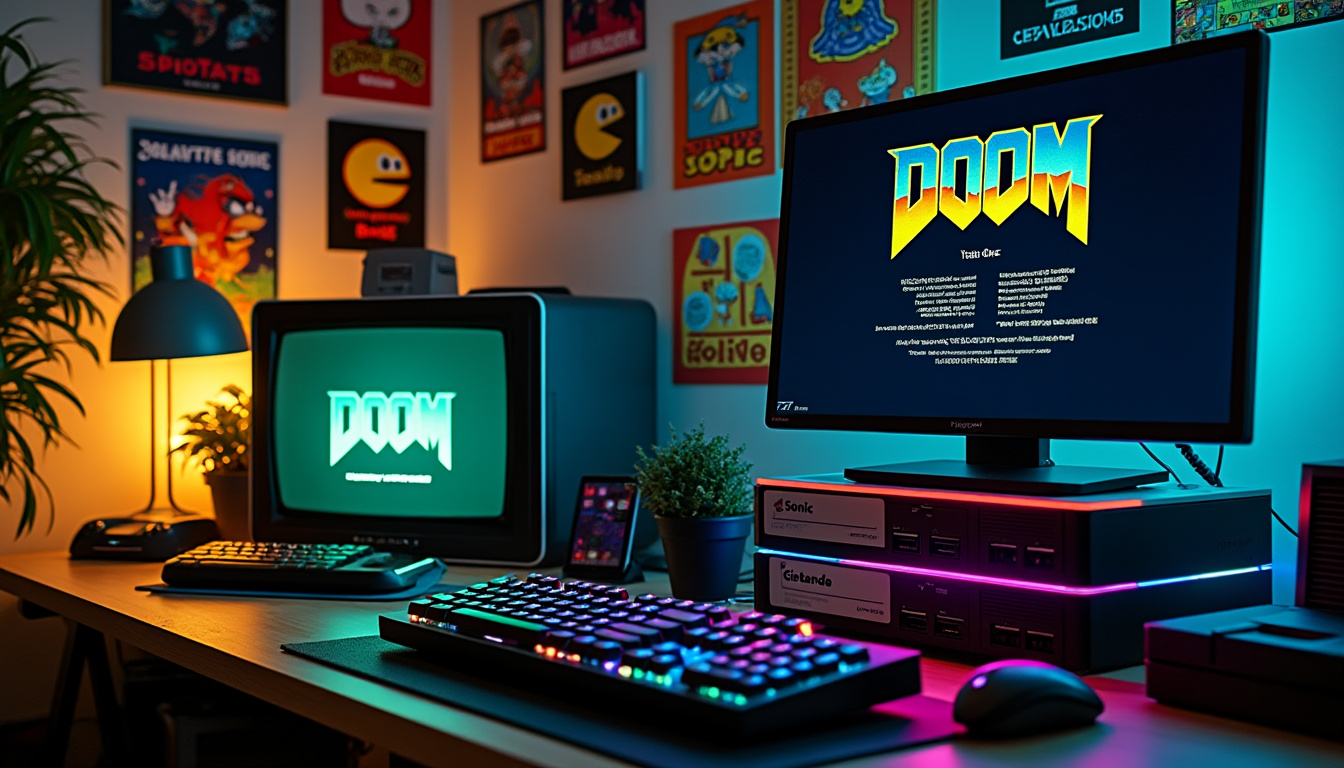|
IN BRIEF
|
Since its groundbreaking debut in 1993, the iconic game Doom has continually pushed the limits of technology and creativity, evolving from a simple pixelated shooter to a cultural phenomenon. This vintage game has not only left an indelible mark on the gaming industry but also sparked a fascinating trend: a myriad of devices, from smart fridges to even pregnancy tests, have been challenged to run it. As developers and tech enthusiasts alike explore the question: Can it run Doom?, the enduring legacy of this classic title serves as a benchmark for innovation and ingenuity.
Since its release in 1993, Doom has not only defined the first-person shooter genre but also become a benchmark for technology enthusiasts who test the limits of hardware capabilities. The uncanny ability of this retro game to run on a wide array of devices—from elevators to calculators—illustrates its enduring legacy. This article explores how “Doom” not only continues to captivate gamers but also challenges emerging technologies in unprecedented ways.
The Legacy of Doom
Upon launch, Doom swiftly became a revolutionary force within the gaming community. Its combination of cutting-edge graphics (for the time), seamless gameplay, and immersive environments set new standards for what video games could achieve. Even decades later, “Doom’s” influence can be seen coursing through the veins of modern titles, proving that its architectural innovations were not just a fleeting moment in gaming history. The original game’s code has been dissected and adapted for numerous platforms, reinforcing its status as a cultural touchstone.
Testing the Limits: Can it Run Doom?
The phrase “Can it run Doom?” has become a humorous challenge among tech enthusiasts. This question has prompted a flurry of experiments where players have successfully run the game on everything imaginable—from smart fridges to artificial intelligence. In fact, researchers have even managed to get “Doom” running on a quantum computer, showcasing its adaptability to the most advanced technologies. This playful inquiry not only highlights the novelty of running such a classic game but also reflects on the evolution of computing power over the years.
Running Doom on Unconventional Devices
From absurdity to ingenuity, the list of devices that have successfully hosted Doom is astonishing. Imagine a game playing on a Tamagotchi, an ATM, or even a calculator! Each port is a testament to the game’s flexibility and the creativity of programmers who strive to push boundaries. This phenomenon invites explorations into the abyss of technological limits, demonstrating how “Doom” serves as a litmus test for performance capabilities.
AI and Doom: The New Frontier
As we delve deeper into the realm of artificial intelligence, Doom has become a canvas for testing the efficacy of AI models. A project known as GameNGen has been unveiled, showcasing AI’s ability to render and interact with the classic game in real-time. This trajectory opens new avenues for both gaming development and AI research, indicating that the challenges posed by “Doom” remain relevant in a world driven by machine learning and artificial intelligence. Additionally, various blogging platforms have begun discussing how AI can reshape the way we play and develop games, including insights from Bletchley Institute.
The Cultural Impact of Doom
Beyond its technical aspects, Doom holds a significant place in our culture and history. It shaped not only gaming but also the approach to software development and distribution. The game spawned an entire subculture of modding and fan-created content, allowing users to tweak and personalize their gaming experience endlessly. This adaptability has solidified “Doom’s” status as a timeless classic that invites both nostalgia and innovation.
With the advent of modern technology, the question of whether something can run Doom has evolved into a broader inquiry into our understanding of computing. As absurd as it may sound, the absurdity of trying to run this vintage game on various devices has paved the way for discussions surrounding performance, creativity, and the limits of technology. With the ongoing love for “Doom“, it seems that as long as there are new devices, there will also be new ways to challenge them with this evergreen game. For more on the origins and legacy of Doom, you can explore its Wikipedia page.
Can It Run Doom? A Challenge for Modern Tech
| Device Type | Performance Insight |
| Smart Thermostat | Capable of running Doom, showcasing unexpected computing power. |
| Pregnancy Test | Successfully runs the game, highlighting versatility of embedded systems. |
| Smart Fridge | Runs Doom as a fun feature, merging utility with entertainment. |
| Quantum Computer | Struggles with Doom; demonstrates limitations despite advanced tech. |
| Calculator | Successfully executes the game, emphasizing efficiency in coding. |
| Smartwatch | Can run Doom, proving compact devices can handle complex software. |
| Old PC | Powers the game effortlessly, representing its retro origins. |
| Raspberry Pi | Effectively emulates Doom, ideal for hobbyist programmers. |
| Home Router | Joke implementation; it can, but not practical! |
Frequently Asked Questions
Q: What is the significance of the game “Doom”?
A: “Doom,” released in 1993, was a revolutionary title that transformed the gaming industry and continues to influence modern technology.
Q: Why is “Doom” able to run on various devices?
A: The game’s simple design allows it to function on a wide array of platforms, from smartphones to unconventional devices like smart fridges and thermostats.
Q: Can “Doom” be played on a quantum computer?
A: Yes, researchers have successfully ported “Doom” to operate on quantum computers, showcasing its adaptability even in advanced tech environments.
Q: What are some unconventional devices that can run “Doom”?
A: “Doom” has been run on devices such as pregnancy tests, calculators, and even among various smart home gadgets, highlighting its versatility.
Q: Why do programmers still experiment with “Doom”?
A: For many programmers, it’s a playful challenge to see how far they can push technology by running “Doom” on unexpected platforms.
Q: What was the original impact of “Doom” on gaming?
A: “Doom” set the standard for first-person shooters and became a benchmark for graphics and game design during its time.
Q: How has “Doom” evolved since its release?
A: The game has inspired numerous ports and adaptations, adapting to new technologies while retaining its core gameplay.
Q: Is “Doom” still relevant in today’s gaming landscape?
A: Absolutely! Its legacy is celebrated, and it is frequently referenced in discussions about game development and programming challenges.



